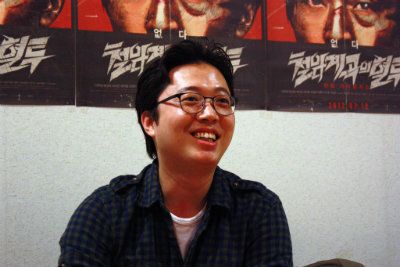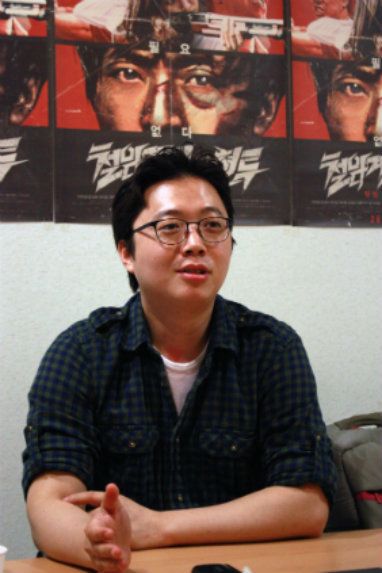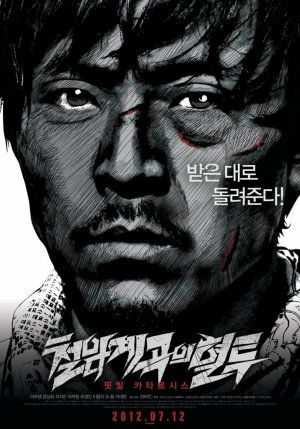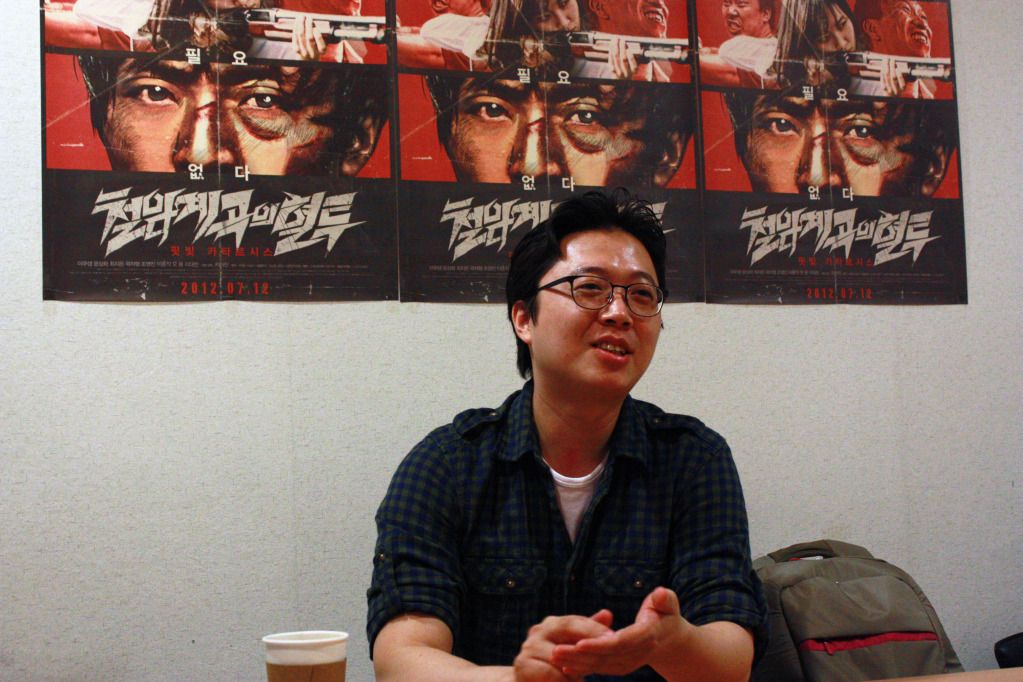During the summer, with images from the New York Asian Film Festival still seared into my brain, I hoped to learn more about one of the festival's less heralded yet highly impressionable films BLOODY FIGHT IN IRON ROCK VALLEY. Shot on a shoestring budget, it's a modern take on the classic Western with a main protagonist driven by revenge (reviewed here). I sought out an interview with the South Korean film's newcomer director JI Ha-Jean. He graciously answered my questions via email, giving thorough insight into his vision and the trials of making a low budget action film.
JI Ha-Jean: Personally I love Western and Crime movies. I especially like the directors Sergio Leone and Jean-Pierre Melville, so I made my film with the idea of learning and practicing their cinematographic heritages in mind.
I decided to make this film after reading the book ‘Rebel without a Crew: Or How a 23-Year-Old Filmmaker With $7,000 Became a Hollywood Player’ by Robert Rodriguez. It’s like the bible of making action films with a micro budget. The reason I chose the Western genre especially is that it suits low budget filmmaking. Following the simple rule, which is ‘a mysterious man visits an isolated village and wipes out all the bad people,’ and shooting well crafted minimal action scenes, I expected the film to come out great even though it was made on a very low budget.
Q: Considering the minimal budget you had to shoot on, were there concessions or improvisations to your plans that you knew you would have to make before shooting started?
JH: The costumes were the hardest part. The extra pieces of clothing are very important for making this kind of movie, in which 17 people die, and most characters get injured or are intensely chased. However, we didn’t have a big enough budget for all the costumes, so most of the characters wore only one outfit until the end of shooting. So I tried to shoot the film in sequential order, but it was difficult. You might have noticed that, repeatedly, characters’ clothes are dirty and later changed to clean; torn and later they look like new. Also, I had to lower my expectations for the blood explosion scenes. There was only one chance, so even though I was not fully satisfied with it, I had to say OK.
At last, we had to finish the shooting within 25 days, so we were always in a rush. We had to revise lots of scenes in order to shoot the action sequences. Especially for the scene where the character ‘AX’ is killed, it was a very complicated scene using wire action, but we finished it within 3 hours. We had to give up lots of details that were in the original plan.
However, with this restriction, the making of the film had a more frenetic vibe, so I think it is not too bad.
 Q: I’ve read that it took something like 2 months to shoot the movie -- incredibly fast! How did you make that happen?
Q: I’ve read that it took something like 2 months to shoot the movie -- incredibly fast! How did you make that happen?JH: I will correct you here; it took just 1 month! It was very important for the staff and actors to get along with each other well in order to finish the film in such a short period. The shooting was done using hand-held filming techniques without any lights. We were always on stand-by. 100% of the sound was done in post synchronization. Actors were very well aware of each roll’s characteristics.
There was different theme music for each character, which we made before the shooting. We used it while shooting and it was very helpful for the actors to keep their emotions on the spot.
Also we had very few members on the staff. This was also helped to make things go fast. It’s also written about in Rodriguez’s book. The staff was made up of 7 people on site. We were always shorthanded, but they were professionals in their fields, which accelerated the process. Also, we knew very well know what we were going to do. We pursued what we could, and quickly decided to give up what was impossible at that moment.
Q: The time and place that the movie is set does not seem clearly defined. It appears like it could be in the present, but not shown in exact detail. Is it meant to be open to interpretation? Did you have a particular time and place in mind?
JH: There is a particular time in the movie. The main character has been released from prison 12 years after 1998, so the background is in 2010.
However, in general I wanted the time to be not defined. In the films of Kurosawa Kiyoshi or Sergio Leone, the era is not clearly defined. So the story in their films has a universal context beyond the particular era.
Korea’s development has been very fast and highly compressed within the last 60 years after the Korean War. There has always been huge demolition and reconstruction in our history, so the tragic story inside ‘Bloody Fight in Iron-Rock Valley’ is quite common in our society. If the background of this movie was not the mining village in Gangwon province, it would have been difficult to blur the time. Because Korea is changing so fast, the old things are vanishing very quickly. However, the mining village of Gangwon province has stayed the same over decades. If we say it is the 1970s, people can still believe it. You could say another main character of this film is ‘space’, so it was very important to establish the atmosphere of the place.
Q: There is a very interesting use of space, for instance, the gang’s base. It seems like it was created using old machinery, other unusual props. How did you give the space the look you wanted?
JH: We didn’t have enough time or budget for designing the setting more. We had to use the location as it was, so we made a big effort while location hunting. The gang’s base is also shot at the location exactly as we found it. There are many abandoned buildings in Gangwon province. So we believed we would be able to find a great spot after checking places carefully.
After confirming the location, we revised the scenario to be suitable for it. I brought pictures of the places home and adapted the scenario and the characters’ moves to the place’s atmosphere.
Q: Several of the actors in the movie, I’m thinking particularly of LEE Moo-Saeng, YUN Sang-Wha, and CHOI Je-un have a very bold/striking look. How did you go about casting and selecting them for the role? Did they agree to work on the movie right away.
JH: I was very lucky with the casting. There are many great actors in the films of Sergio Leone, Howard Hawks and Sam Peckinpah. In their movies, the actor’s face is the characters itself. I especially like Walter Brennan, Charles Bronson, and Warren Oates.
For the ideas, I tried to find the answers within the actors’ faces. For instance, LEE Moo-saeng, his face is very bold, has a striking appearance and his eyes express quite a gloomy feeling. When I shot extreme close-ups of his eyes, I could see a sad man with a big hurt memory. However, he also looks very strong and restrained.
YUN Sang-hwa looks very violent, but also exhausted from the wrinkles on his face. In the movie, there is only one time his hat is taken off, and that is where he looks the shabbiest. Also, he shows different aspects of his look in the flashback scenes.
CHOI Je-un is a sassy girl working in the gambling house. But she is also a sweet girl, going to her father’s temple every day. Ms. CHOI has a proper look in that aspect. Also she knows how to handle guns very well.
The western genre is very rare in Korean cinema, so most of the actors were intrigued by that. I also persuaded them with my convictions to make a great western film. It helped them to get on board the project.
Q: The movie is notable for action sequences and use of different weapons (a torch, nail gun, shotgun, etc.) Were there any particular influences on directing the action/violence in the movie? Any interesting stories/challenges about doing scenes with that type of equipment?
JH: There are particular muggers who carry out orders of others in Korea. They use those kinds of tools to control people. One day, there was an event that influenced the story of this movie: a mugger blasted fire into a woman’s mouth and damaged her throat.
Korea strictly prohibits guns. This movie is a western, but if the characters were fighting with guns, it would turn into a 100% fantasy movie. No possibility at all. I wanted to have some plausibility in the film, so I decided to work with the tools that these muggers usually use.
I shot double the number of nail-gun scenes that end up appearing in the film. But it made the main character seem too violent, so I deleted half of them.
The last fight between Chul-ki and Ghost Face (Gyee-myeon) is the most important part of the film, so I tried to make the rest of action scenes less violent.
Also, when Chul-ki killed the AX, the fact that he is killed by the amulet which he was always attached to was more important than the manner of killing itself.
I incorporated the back stories into every action scene. Making the audience think of Chul-ki’s sadness was more important than the action itself.
We used a real ax in the film. We couldn’t make the fake ax, so we used a real one, which is very heavy and sharp.
When we shot the scene in which AX tries to kill Chul-ki lying down on the ground using an ax, it could have been a major accident. Mr. LEE refused to shoot the scene anymore because it was too dangerous. He felt threatened.
So the action choreographer make-up director and Mr. LEE tried to make a fake ax midway through shooting. It was made of PVC pipes and Styrofoam, but it looked really good, just like a real one. It looked so real that I was so surprised and felt guilty for the actors because I couldn’t think of making one at the beginning.
As a result, we could make a strong scene using that model. Thanks to their passion and affection for the film, we could get great results.
Q: The movie tells a very straightforward revenge story, but you also incorporated issues of corruption and greed into it - a developer trying to force people out of their land to build something more profitable. How did you decide to make this part of the story? Was it an issue of particular importance to you?
JH: I think I already gave you the answer to this above. Korea has developed very rapidly, so people these days are living in more prosperous and convenient times. On the other hand, people in this society just keep going without consideration for others who are isolated and ignored.
This movie is fictional, but it also points out some of the problems in this society.
Just 4 years ago, 6 laborers were burned to death during a fight with policemen in Seoul. The labors wanted to keep living in their area, so they fought with the policemen who tried to remove them. However, it caused too much harm. This was a very violent event, but a new building was constructed on the spot where it happened. And people seemed to have forgotten the event very fast.
Gangwon province has such a beautiful landscape and great natural resources underground, so similar things easily happen. The people who have lived there are kicked out, and developing facilities are occupying those places.
I started developing this film with the idea that among these many victims, there might be a personal story about one individual who tries to get revenge. This movie is for entertainment, of course, but I thought that it could gain the sympathy of the audience as long as it is based in reality.
Also, it addresses the eternal theme of the ‘revisionist western’.
Q: The ending has a somewhat serial-like feeling to it? Do you have interest in developing a sequel? If not, what type of project are you interested in taking on next?
JH: You’ve got the idea correctly, but I don’t have a plan for a sequel. When the main character ‘Chul-ki’ disappeared at the end, I hoped he wouldn’t get into any more trouble afterwards.
However, I have a plan for a bigger western movie in the future. The time of the film would be further in the past. The background would be the era when the train railroad was constructed for the first time in Korea. The ‘Mr. No Name’ will appear again and he will fight with a harsher enemy.
The project I am currently working on is a horror film. I will bring forth a great horror film with lots of blood, mixed with action and adventure. Please don’t miss it!



this interview makes me want to revisit this movie again. Nicely thought out, revealing, & candid answers from the director. It gets me excited to watch the movie again from a different perspective.
ReplyDelete
ReplyDeleteI thought it very cool reading his responses about the fight scenes, the efforts to attain a sense of realism, and the innovations they used. I'd like to see these again, too, paying greater attention to the details!